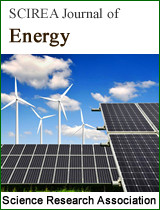Techno- Economics of a Hybrid Photovoltaic Wind Turbine
DOI: 10.54647/energy48149 87 Downloads 230391 Views
Author(s)
Abstract
To improve the overall energy production from the wind turbine and lower the levelized cost of energy (LCOE), an innovative approach for the design of a hybrid solar-wind turbine (HSWT) is proposed. The present concept is based on installing arrays of solar panels on the south-facing facade of the turbine tower to generate electricity from sunlight. The hybrid offers greater benefits compared to separate systems. An example is given of an offshore WT with a rated capacity of 4.7 MW forming part of a 600 MW wind farm in the North Atlantic. The 100 m high tower is covered with 465 PV panels of 340 W capacity. For evaluation, the gross resource of each renewable is estimated considering the specifications of the available data In the discussion, the LCOE’s of wind and the hybrid solar-wind combination are compared. From the results, it is clear that HSWT offers a reduced LCOE, even after allowing for shading losses from the blade, and a much steadier production of energy. The introduction of HSWT would help to make wind farms a more cost-effective and competitive source of clean energy.
Keywords
Solar; wind-turbine; hybrid; tower; LCOE
Cite this paper
Cawas Phiroze Nazir,
Techno- Economics of a Hybrid Photovoltaic Wind Turbine
, SCIREA Journal of Energy.
Volume 6, Issue 6, December 2021 | PP. 95-112.
10.54647/energy48149
References
| [ 1 ] | Scott Brownhttps://www.renewableenergymagazine.com/wind/strategic-alliance-to-produce-a-groundbreaking 10th Oct 2011 |
| [ 2 ] | Combined Floating Offshore Wind and Solar PVMario López, Noel Rodríguez and Gregorio Iglesias ,http://www.mdpi.com/journal/jmse 30 July 2020 |
| [ 3 ] | https://en.wikipedia.org/wiki/Gujarat_Hybrid_Renewable_Energy_Park |
| [ 4 ] | Tina, G., Gagliano, S., and Raiti, S. “Hybrid solar/wind performance assessment”, Solar Energy, Vol. 80, pp. 578-588, 2006 |
| [ 5 ] | Kershman, S.A., Rheinlander, J., Neumann, T., andGoebel, O. “Hybrid Wind/PV and Conventional Power ForDesalination In Libya – GECOL Facility For Medium And Small Scale Research At Ras Ejder”, Desalination, Vol.183, No. 1-3, pp. 1-12, 2005. |
| [ 6 ] | Celik, A.N. “Techno-Economic Analysis Of AutonomousPV-Wind Hybrid Energy Systems Using Different SizingMethods”, Energy Conversion And Management, Vol. 44, pp. 1951-1968, 2003. |
| [ 7 ] | Bakos, G.C., and Tsagas, N.F. “Techno-economic assessment Of A Hybrid Solar/Wind Installation ForElectrical Energy Saving”, Energy and Buildings, Vol. 35, No. 2, pp. 139-45, 2003 |
| [ 8 ] | Deshmukh, M.K., Deshmukh, S.S. “Modeling Of hybrid renewable Energy Systems”, Renewable and Sustainable Energy Reviews, Vol. 12, No. 1, pp. 235-249, 2008 |
| [ 9 ] | Lawrence D. Willey Design and development of megawatt wind turbines WIT Transactions on State of the Art in Science and Engineering, Vol 44, © 2010 WIT Pressdoi:10.2495/978-1-84564-205-1/06 |
| [ 10 ] | (https://kohilowind.com/kohilo-university/202-types-of-wind-turbines-their-advantages-disadvantages/ |
| [ 11 ] | http://energy.gov/energysaver/articles/hybrid-wind-and-solar-electric-systems July 2012 |
| [ 12 ] | Tyler Stehly, Donna Heimiller, and George Scott 2016 Cost of Wind Energy Review Technical ReportNREL/TP-6A20-70363 December 2017, www.nrel.gov/publications |
| [ 13 ] | Dodge, D.M., Illustrated History of Wind Power Development, Littleton, Colorado, 1996 -2005. http://www.telosnet.com/wind/index.html |
| [ 14 ] | Beiter, P., W. Musial, L. Kilcher, M. Maness, A. Smith. 2017. An Assessment of the Economic Potential of Offshore Wind in the United States from 2015 to 2030 (Technical Report), NREL/TP-6A20-67675. National Renewable Energy Laboratory (NREL), Golden, CO (US). |
| [ 15 ] | GiffordConcrete Towers for Onshore and Offshore Wind Farms, www.concretecentre.com ISBN 1-904818-48-X, 2017 |
| [ 16 ] | Parida, B.; Iniyan, S.S.; Goic, R. A review of solar photovoltaic technologies. Renew. Sustain. Energy Rev.2011, 15, 1625–1636. [CrossRef |
| [ 17 ] | Christian Brown Shading Losses in PV systems, and Techniques to mitigate them https://www.aurorasolar.com/blog/shading-losses-for-pv-systems-and-techniques-to-mitigate-them/ |
| [ 18 ] | The research investigates the shady role of wind turbineshttps://www.energylivenews.com/2021/11/02/research-investigates-the-shady-role-of-wind-turbines/ |
| [ 19 ] | NREL (National Renewable Energy Laboratory), 2017. PV Watts Calculator. |
| [ 20 ] | Enercon GmbH, Tower Versions, 2004. Available from: www1.enercon.de |
| [ 21 ] | Panasonic https://na .panasonic.com/us/solar support?series=778018product=62766 |
| [ 22 ] | C. Deline Partially shaded operation of a grid-tied PV system Conference Paper NREL/CP-520-46001 June 2009 https://www.nrel.gov/docs/fy09osti/46001.pdf |
| [ 23 ] | Salih Mohammed Salih, Mohammed Qasim Taha Analysis of Shading Impact Factor for Photovoltaic Modules https://www.researchgate.net/publication/273773634 |
| [ 24 ] | us solar photovoltaic system cost benchmark 2020 Technical Report NREL/TP-6A20-77324 Jan 2021 https://www.nrel.gov/docs/fy21osti/77324.pdf |
| [ 25 ] | Future of Wind – A Global Energy Transformation paper –IRENA https://www.irena.org/-/media/Files/IRENA/Agency/Publication/2019/Oct/IRENA_Future_of_wind_2019.pdf https://www.nrel.gov/docs/fy17osti/67675.pdf. |
| [ 26 ] | Global Solar Atlas – Wikipediaen.wikipedia.org › wiki › Global_Solar_Atlas |
| [ 27 ] | Mario López 1 , Noel Rodríguez 1 and Gregorio IglesiasCombined Floating O_shore Wind and Solar PVJ. Mar. Sci. Eng. 2020, 8(8), 576; https://doi.org/10.3390/jmse8080576 |

